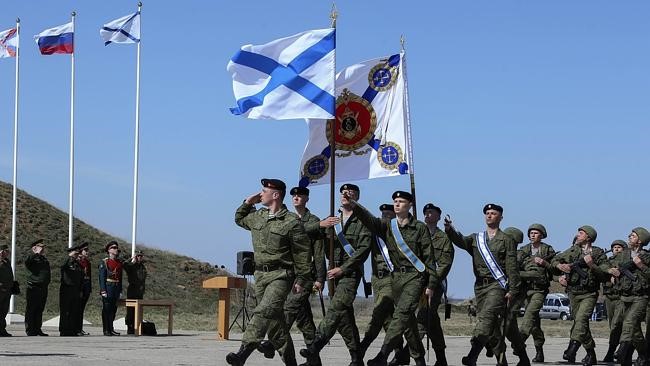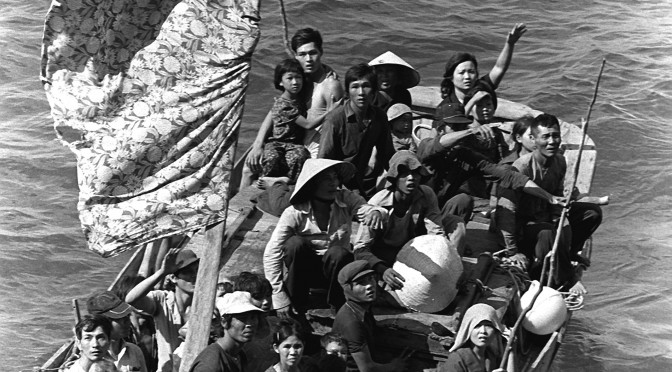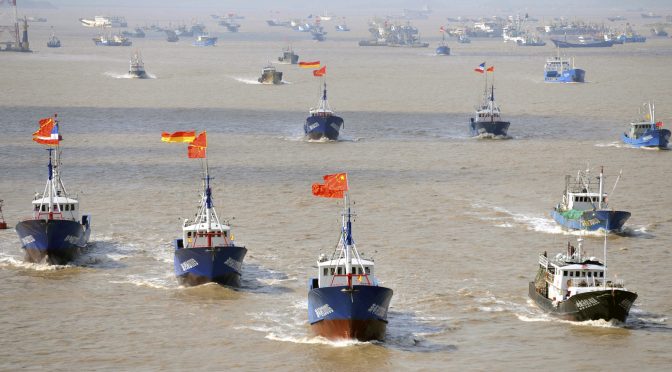By Andrew S. Erickson and Conor M. Kennedy
Maritime militia, dead ahead! In a just-published Defense News article, Chris Cavas has made an important contribution to our understanding of the operations and applications of China’s irregular maritime forces. The forces he describes are almost certainly neither ordinary merchant ship operators nor random fishermen, but rather militiamen operating in pre-planned roles in conjunction with USS Lassen’s Freedom of Navigation Operation (FONOP) in the South China Sea (SCS) on 27 October 2015.
Cavas cites a U.S. Navy source: “‘There were Chinese merchant vessels present that were not as demure as the Chinese Navy. One came out of its anchorage in the island and crossed the destroyer’s bow but at a safe distance, and the Lassen did not alter course as the merchant ship circled around.’ Fishing vessels in the area added to shipping traffic in the immediate area, the source said, but the ship did not have to maneuver around them. But the extra craft seem to have been present, the source noted, ‘because they anticipated the Lassen’s transit.’”
In what follows, the authors trace maritime militia involvement—in close coordination with other Chinese maritime forces—to a variety of important incidents at sea. It is thus not surprising to see these forces active near such China-occupied Spratly features as Subi Reef. But greater awareness is needed to address this vital but too-long-understudied issue. To that end, we offer the following major points:
- China’s maritime militia is understudied, but it is important for understanding Beijing’s maritime strategy, especially in the SCS.
- The militia work with other instruments of Chinese sea power—the military and the coast guard—to defend and advance China’s position in its disputes. They may also support military operations in wartime.
- They allow China to vigorously pursue objectives without risking military conflict or creating an image of gunboat diplomacy.
- This article series will profile four of the most important militia units operating in the SCS.
While Russia has employed “Little Green Men” surreptitiously in Crimea, China uses its own “Little Blue Men” to support its outstanding island and maritime claims in the East and South China seas. These maritime militia forces have participated in some of Beijing’s most important military and paramilitary operations in the SCS. They will be directly involved in future Chinese efforts, possibly including the direct harassment of U.S. and allied FONOPS. By “sending civilian, rather than military, ships to track or confront U.S. Navy vessels,” explains Huang Jing of the National University of Singapore, “China can issue a firm response to the U.S. while signaling that they don’t want to escalate the situation militarily.”
No ordinary civilian fishing boats, these! They are operated by members of China’s maritime militia (海上民兵). These irregular forces are recruited from a local fishing community or other maritime industry and remain employed there while being trained and available for government tasking. China’s modern maritime militia building dates to the founding of the People’s Republic of China (PRC) in 1949, when a rudimentary People’s Liberation Army Navy (PLAN) faced Nationalist blockading of mainland ports and depredations against merchant vessels. As a stopgap measure, the nascent PRC trained and equipped its fishermen militias, both for their self-defense and to support ground and naval operations. Within today’s maritime militia, a small but growing set of elite units are the ones most likely to be deployed on more sophisticated operations that involve monitoring, displaying presence in front of, or opposing foreign actors. They frequently operate in concert with China’s navy and coast guard.
The PLA’s official newspaper states, “putting on camouflage they qualify as soldiers, taking off the camouflage they become law abiding fishermen.” Make no mistake: when national needs dictate, maritime militia are used as frontmen trolling in support of territorial claims. You can read our analysis to date here, here, here, and here. Now, with the potential role and impact of China’s maritime militia growing, it’s time to document their precise nature before Beijing is able to mischaracterize or selectively portray an interaction or incident as simply involving random civilian fishermen or other marine workers motivated by spontaneous patriotism unfairly oppressed by foreign forces.
The concept of deputizing civilians to perform state functions is not novel to China. The United States, for instance, has Naval Militia, as well as Coast Guard Auxiliary and a Craft of Opportunity Program—but they serve vastly different purposes. Many states’ naval militias, such as the Rhode Island Naval Militia, are not currently active. Only the New York Naval Militia has remained continuously active since its founding. The few that have remained active post-World War II or recently (re)activated assist with law enforcement, evacuations, disaster recovery, anti-terrorism, and defense of undisputed American territory and port facilities against mines and other hazards. Importantly, U.S. Naval Militias, like the U.S. Coast Guard, do not harass foreign vessels or conduct other assertive activities to further contested island or maritime claims. In fact, the United States has very few contested claims, and has a track record of adhering to international law to manage or resolve them. It does not resort to harassment or threats of force against foreign vessels regarding disputes; hence there is no need for its Naval Militias to do so.
By contrast, such “maritime rights protection” activities are important responsibilities for China’s leading irregular maritime forces. Selected elite Maritime Militia units prepare for the most advanced missions, in part by receiving training from the PLA Navy (PLAN). As the first article in our series will explain, Vietnam, one of the few other countries with a Maritime Militia similar to China’s in purpose, knows about their efforts only too well. Chinese maritime militia capabilities are poised to grow still further as Beijing’s desire for calibrated SCS operations grows and demobilized military forces may be offered as a result of Xi Jinping’s 300,000-troop downsizing to make the PLA, literally, leaner and meaner.
To challenge future U.S. and allied FONOPS, in addition to verbal challenges and conspicuous monitoring and tracking, Beijing will attempt to further portray itself as the victim of foreign predations, forced to respond “defensively.” In addition to close, ambiguous approaches by China coast guard vessels or aircraft, which—unlike naval warships—are not subject to the bilaterally-accepted Code for Unplanned Encounters at Sea (CUES) or the associated air annex, it may entail closer, even more ambiguous approaches by maritime militia forces. The vast majority would likely operate trawlers, but some may employ other marine economic assets as well, such as the “merchant vessel” that cut in front of USS Lassen. Beijing may attempt to mischaracterize or selectively portray an interaction or incident as simply involving random civilian fishermen or other marine workers and “island residents” unfairly oppressed by foreign forces motivated by spontaneous patriotism—when in fact these are irregular selectively-uniform-wearing forces controlled by the PLA through land-based military People’s Armed Forces Departments (PAFDs). It will also require proactivity and getting out ahead of Beijing’s narrative. Among other things, the U.S. government should document to the world the nature of China’s maritime milita and its government-controlled deception and harassment activities. That will be far easier and more effective before Beijing orchestrates any militia-related confrontation.
To better understand these important dynamics and their strategic, operational, tactical, and policy implications, the authors will therefore offer a series of five articles on the vanguard militia forces of Hainan Province, most relevant to SCS disputes. Four of the leading militias will be surveyed in depth.
- Located on Hainan’s west coast, the Danzhou Militia of Baimajing Harbor played a significant role in China’s operation to seize the Crescent Group of islands from Vietnam in the January 1974 Battle of the Paracel Islands.
- Established in 1985, the Tanmen Village Maritime Militia Company of Qionghai County on Hainan’s south-southeast coast has long delivered supplies and building materials to China’s Spratly outposts. It was directly involved in the April 2012 Scarborough Shoal Standoff, with the boats of Chen Zebo and another Squad Leader likely summoning Chinese coast guard intervention when boarded by Philippine Navy forces seeking to confiscate a diverse harvest of endangered marine species. The Tanmen Militia benefited greatly from a visit by Xi himself on 8 April 2013, after which Tanmen Village was declared a model village and received further government investment.
- Learning from the model set forth by the Tanmen Militia, the Sansha City Maritime Militia was established in its new, eponymous municipality in 2013. Given its location, it promises to play an important role in future Paracel affairs.
- Last but not least, based in Sanya City near the center of Hainan’s southern coast, is the Sanya maritime militia built out of entities like Fugang Fishery Co. Ltd., which was established in 2001. Given its status as the militia perhaps most likely to be used for near-term frontline operations, such as harassment against U.S. or allied FONOPS, it is the subject of this first article in our series.
Read Part One Here.
Dr. Andrew S. Erickson is an Associate Professor in, and a core founding member of, the U.S. Naval War College’s China Maritime Studies Institute. He serves on the Naval War College Review’s Editorial Board. He is an Associate in Research at Harvard University’s John King Fairbank Center for Chinese Studies and an expert contributor to the Wall Street Journal’s China Real Time Report. In 2013, while deployed in the Pacific as a Regional Security Education Program scholar aboard USS Nimitz, he delivered twenty-five hours of presentations. Erickson is the author of Chinese Anti-Ship Ballistic Missile Development (Jamestown Foundation, 2013). He received his Ph.D. from Princeton University. Erickson blogs at www.andrewerickson.com and www.chinasignpost.com. The views expressed here are Erickson’s alone and do not represent the policies or estimates of the U.S. Navy or any other organization of the U.S. government.
Conor Kennedy is a research assistant in the China Maritime Studies Institute at the US Naval War College in Newport, Rhode Island. He received his MA at the Johns Hopkins University – Nanjing University Center for Chinese and American Studies.





 Join our DC chapter for its November informal meet-up/happy hour. Chapter President Scott Cheney-Peters will lead a short discussion and participatory exercise on trends affecting maritime security developments in the next 20 years, from technology to geopolitics. We hope you’ll drop by for drinks and discussions with friends old and new.
Join our DC chapter for its November informal meet-up/happy hour. Chapter President Scott Cheney-Peters will lead a short discussion and participatory exercise on trends affecting maritime security developments in the next 20 years, from technology to geopolitics. We hope you’ll drop by for drinks and discussions with friends old and new.